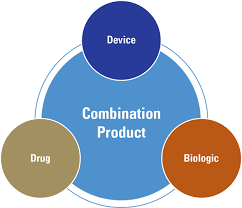
Combination Product Development

A combination product is defined as a product composed of two or more different types of medical products, such as a drug, a device, and/or a biological product.
TYPES OF COMBINATION PRODUCTS
- Single-entity products: Prefilled syringes, drug-eluting stents, and transdermal patches.
- Co-packaged products: First-aid kits containing bandages and pain-relieving drugs.
- Cross-labeled products: A drug packaged separately from a device, but labeled for use with that specific device.
- Drug/Device: Prefilled syringes, drug-eluting stents, and transdermal patches.
- Device/Biological Product: Catheters with antimicrobial coatings, condoms with spermicide.
- Drug/Biological Product: Monoclonal antibody combined with a therapeutic drug.
- Drug/Device/Biological Product: Some products can combine all three types of products.
REGULATORY CONSIDERATIONS
- Combination products are regulated by the FDA, but because they involve components that are typically regulated by different FDA centers, they can present regulatory challenges.
- The FDA has established the Office of Combination Products (OCP) to address issues related to the regulation of these products.
- The OCP develops guidance, regulations, and standard operating procedures to clarify combination product regulation.
- The FDA expects to receive large numbers of combination products for review as technological advances continue to blur the lines between product types.
The Office of Combination Products (OCP) issues classification and jurisdiction assignments for human medical products. The classification of a product determines the type of a product (drug, device, biological product, or combination product). Jurisdiction determines the FDA Center or Lead Center (CBER, CDER, or CDRH) that will regulate the product. For questions about the RFD process, you may contact OCP directly.
Regulatory Pathway: The regulatory pathway for a combination product depends on the primary mode of action of the product.
Marketing Authorization: Combination products are typically marketed under a marketing authorization type associated with the constituent part that provides the primary mode of action.

